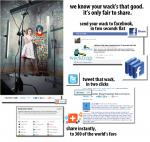What’s your story?
Share and find customer experiences
Connect with the people behind them
Wacktrap is
feedback made social
Trending Content
Sprint Plans Rate Hike for Android Cell Phones AT&T Verizon Expected to Increase
by editor

With virtually every move set to spark price hikes industry-wide, like the airlines, Sprint Nextel announces a price increase for “smart phones” that surf the web. Android and Black Berry cell phone users can expect a $10 increase after January 30 or when their current contract expires. AT&T and Verizon are expected to follow Sprint’s lead in a rate hike.
As of month’s end on January 30, smart-phone users activating new mobile phone handsets will pay an extra $10 a month – the increase, Sprint says, because those consumers use 10 times the data as customers with simpler handsets. Not that Sprint ever considered instead lowering rates, for customers who don’t use as much data.
At about 80 bucks a month under the new rate increase, Sprint’s data plan still maeks the cell phone provider cheaper than either of its main competitors -- AT&T and Verizon. The bad news for customers is that the cheapest in an industry can dictate fees and rate hikes industry-wide. The move by Sprint, and expected reaction in the form of rate increases by other cellular providers, is eerily similar to how Spirit Airlines affected the entire travel industry: while in the role as the most economic airline for passengers to fly, the fees that Spirit introduced rapidly became standard throughout the entire airline industry. Similarly, this rate hike by Sprint could be significant and change the cellular industry as customers know it: bumped-up rates, based on phone device type, could become standard after Sprint institutes the new rate.
Verizon Wireless and AT&T — Sprint’s main competitors — currently remain mute on the subject of possible, upcoming rate changes for cell phones like "smart phones." The expectation is that the other major cellular providers will in fact follow suit: it’s more a matter of “when” than “whether.”
Stock analysts claim that the cellular phone industry needs to adjust prices in order to reflect the fast-growing Internet and data traffic that has moved from computers to cell phones. The suggestion is that consumer prices should go up, to accommodate cost of improving and maintaining networks in order to carry the load. Of course, no one in the cell phone industry bothers to suggest the possibility that prices should actually go down, to adjust for the lack of service and over-taxed towers that have resulted from promotions that batter the networks and existing customers. In efforts to entice new customers, the major providers have over-burdened networks with promos that include the opportunity to add up to five phones.
Sprint’s increased rates will apply to new customers and for customers upgrading from basic “feature phones” to “smartphones” – devices that include the likes of BlackBerry devices and cell phones using Google’s Android software. For customers already using Sprint smart phones, there’ll be no price increase until the customer’s current contract, typically two years in duration, expires. New customers -- or existing customers not under contract but upgrading to phones like the increasingly-popular Android -- will be subject to the extra ten bucks per month for what Sprint now dubs its “premium data” service.
Sprint’s 4G cell phone customers – using the technology that is supposed to rival landline-like speeds on Sprint’s WiMax network (requiring the Epic, Evo or just-released Evo Shift cell phones to garner the 4G speed) are already paying the bumped-up data plan rate through Sprint. The January 30 rate hike is a bit of a burn for Sprint customers – who will only be receiving 3G service -- to be paying the same increased rate as 4G customers.
In the first nine months of 2010, Sprint reported cash losses of $2.5 billion.
With technology advances and the most recent surge in Android phones, traffic on wireless networks is now dominated by smart phones. At the close of 2009, 49 percent of Sprint cell phone sales were for smart phones — including the Palm Pixi or Pre, BlackBerry devices and Android devices. Nine months later, in the third quarter of 2010, numbers for smartphone sales had skyrocketed to 60 percent.
With at least 60% of its customer base now using phones that will be subject to the new rate increase it has planned, Sprint will be recouping that 2.5 billion loss fairly quickly.
SPEED UP YOUR ONLINE GROWTH
How To Wack
Take the Tour
Click on any image to start










